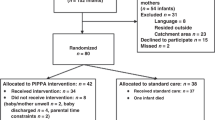Abstract
This study of 31 infants in neonatal intensive care and their parents examined the relationship involving infant characteristics (medical and behavioral), parent characteristics (personality and situational variables), and the development of parental attachment. As expected, infants who were more visually competent had mothers who were more attentive. Contrary to expectation, greater prematurity was related to greater parental involvement. There were important differences in maternal and paternal responses, with mothers using more denial to cope with the medical crisis. Parents who relied heavily on denial were found to have impaired attachment.
Similar content being viewed by others
References
Ambuel, J., & Harris, B. Failure to thrive: A study of failure to grow in height and weight.Ohio Medical Journal, 1963,59, 997–1001.
Caplan, G. Patterns of parental response to the crisis of premature birth.Psychiatry, 1960,23, 365–374.
Caputo, D., & Mandell, W. Consequences of low birth weight.Developmental Psychology, 1970,3, 363–383.
Field, T. Maternal stimulation during infant feeding.Developmental Psychology, 1977,13, 541–542.
Fantz, R. L., & Nevis, S. Pattern preferences and perceptual-cognitive development in early infancy.Merrill-Palmer Quarterly of Behavior and Development, 1967,13, 77–108.
Green, N., & Solnit, A. Reactions to the threatened loss of a child: A vulnerable child syndrome.Pediatrics, 1964,34, 58–66.
Holmes, T. H., & Rahe, R. H. The social readjustment rating scale.Journal of Psychosomatic Research, 1967,11, 213–218.
Kaplan, D., & Mason, E. Maternal reactions to premature birth viewed as an acute emotional disorder.American Journal of Orthopsychiatry, 1960,30, 539–542.
Kennell, J., Jerauld, R., Wolfe, H., Chester, D., Kreger, N., McAlpine, M., Steffa, M., & Klaus, M. Maternal behavior one year after early and extended post-partum contact.Developmental Medicine and Child Neurology, 1974,16, 1972–1979.
Klaus, M., & Kennell, J. H. Mothers separated from their newborn infants.Pediatric Clinics of North America, 1970,17, 1015–1037.
Klein, M., & Stern, L. Low birthweight and the battered child syndrome.American Journal of Diseases of Children, 1971,122, 15–18.
Leifer, A., Leiderman, P., Barnett, C., & Williams, J. Effects of mother-infant separation on maternal attachment behavior.Child Development, 1972,43, 1203–1218.
Locke, H. J. & Wallace, K. M. Short marital-adjustment and prediction tests: Their reliability and validity.Marriage and Family Living, 1959, 251–255.
Lubchenco, L. O., Delivoria-Papadopolous, M., & Searls, D. Long-term follow-up studies of prematurely born infants.Journal of Pediatrics, 1972,80, 509–512.
Osofsky, J. D., & Danziger, B. Relationships between neonatal characteristics and motherinfant interaction.Developmental Psychology, 1974,10(1), 124–130.
Robson, K., & Moss, H. Patterns and determinants of maternal attachment.Pediatrics, 1970,77, 976–985.
Robson, K., Pederson, F., & Moss, H. Developmental observations of diadic gazing in relation to the fear of strangers and social approach behavior.Child Development, 1969,40, 619–627.
Schaefer, E. S., & Manheimer, H.The Post-Partum Research Inventory. Paper presented at the Eastern Psychological Association meeting, 1960.
Shaheen, E., Truskowsky, M., & Barbero, G. Failure to thrive: A retrospective profile.Clinical Pediatrics, 1968,7, 255–261.
Sigman, M., Kopp, C. B., Littman, B., & Parmelee, A. H. Infant visual attentiveness in relation to birth condition.Developmental Psychology, 1977,13, 431–437.
Wright, B.Parental attachment to premature and seriously ill infants. Unpublished masters thesis, Michigan State University, 1977.
Zuckerman, M., & Lubin, R.Manual for the Multiple Affect Adjective Checklist. San Diego, Calif.: Education and Industrial Testing Service, 1965.
Author information
Authors and Affiliations
Additional information
This study is based on a M. A. thesis submitted to Michigan State University by the first author under the direction of the second author. The authors are grateful for the support and assistance of Thomas Helmrath, M. D., Elizabeth Seagull, Ph.D., Dess Johnson, M.S. W., and the staff of the Regional Neonatal Intensive Care Unit at E. W. Sparrow Hospital.
Rights and permissions
About this article
Cite this article
Wright, B.M., Zucker, R.A. Parental responses to competence and trauma in infants with reproductive casualty. J Abnorm Child Psychol 8, 385–395 (1980). https://doi.org/10.1007/BF00916382
Revised:
Issue Date:
DOI: https://doi.org/10.1007/BF00916382




